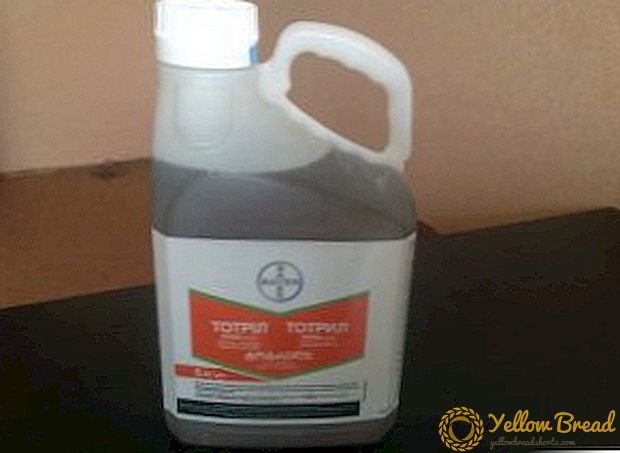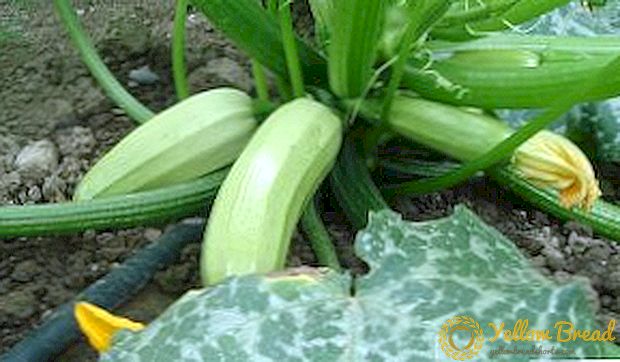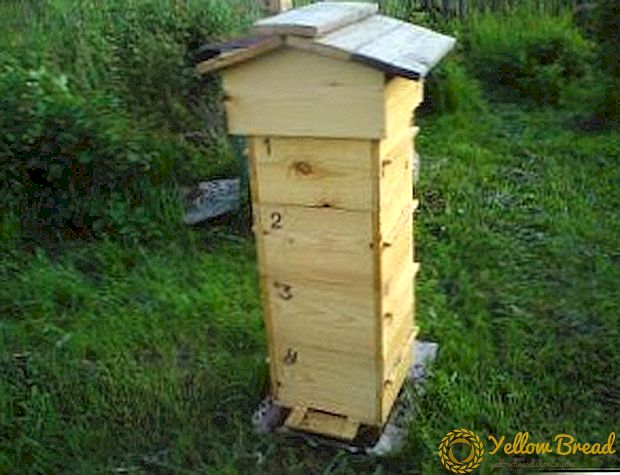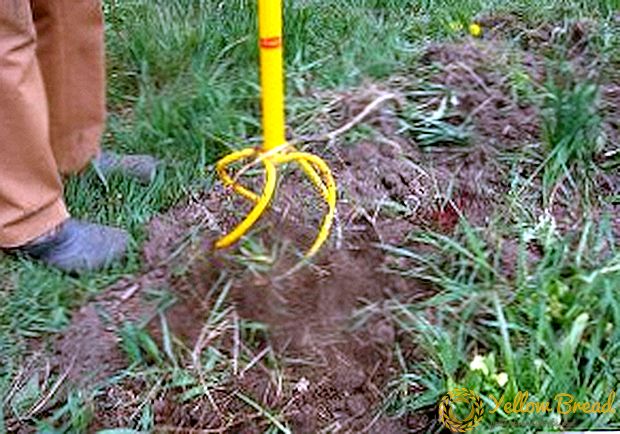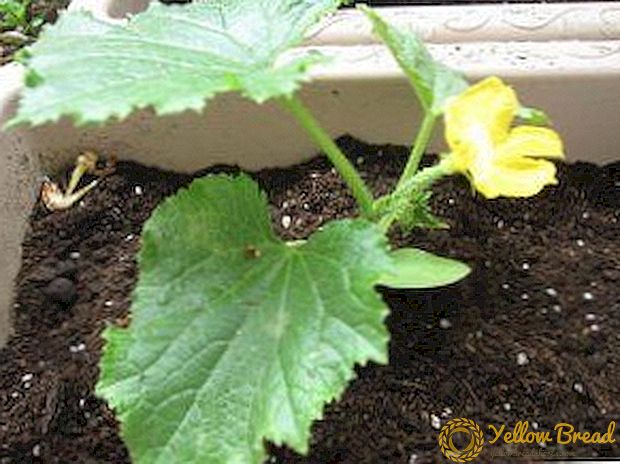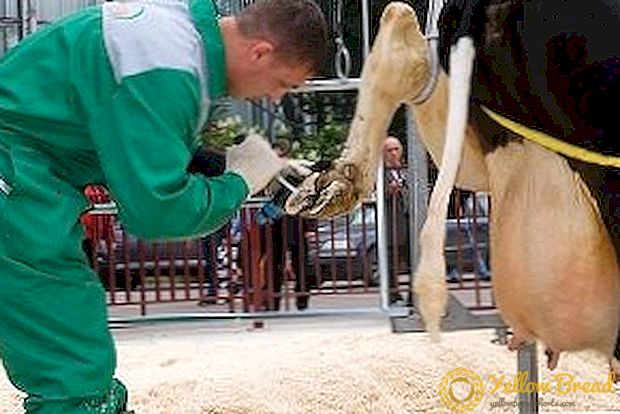
Every animal must be carefully looked after.
And the care is not only in the regular feeding of feed and changing litter, but also in the care of the appearance of the animal.
Here, for example, cattle need not only to be regularly washed and cleaned, but also to trim hoofs in time, as well as to clean the feet.
After all, the cow’s hooves are alone for life.
How to carry out this procedure correctly so as not to harm the animal?
Answers to your questions are given in this article.
It is known that cows and bulls have a hoof, or rather its horn wall, each month thickens and lengthens by 6-8 mm. When the animal walks most of the time through the pasture, this weave is quickly erased, and the shape of the hoof does not change.
In winter, when the cow is inactive, the non-removed cornea may thicken too much, which leads to deformation of the hoof, and such a defect is very difficult to fix.
If this part of the animal's body is not put in order in time, then over time this horn will crack, bend. Then the probability increases soft tissue damage legs and hooves of a cow.
Often there are cases of purulent process and inflammation.Then the animal begins to limp badly.
In order not to bring pain to herself, the cow begins to walk incorrectly, which, in turn, leads to uneven distribution of body weight on the joints.
General animal condition also deteriorates. It becomes difficult for a cow to walk, she does not eat well, tries not to get up on her feet. All this is reflected in milk yield.
Often the amount of milk collected from this cow is reduced by a quarter, but sometimes this cow may not produce milk at all. It is for these reasons that the hoof cleaning and pruning should be performed at least twice a year.

To trim the hooves of a cow on its front legs, you need at least 2 people.
The animal is tied tightly with a short rope to the feeder, one person holds the leg bent at the joint, and the second cuts and cleans the hoof after disinfection. If any damage to the skin has been detected, wounds need to be carefully treated iodine or birch tar.
With hind legs things are even worse. To trim the hooves on these limbs, the cow needs to be thrown to the ground, which is difficult to do. For this you need at least 3 people. Often an animal is injured when it is attempted to be thrown to the ground.
Today, there are special machines in which animals are fixed, and the harm to cows is minimal.
But what if you have one cow that needs to trim and clean the hooves?
There is one technique that allows you to fix the animal alone and carry out the entire procedure.
In order to knock down the animal, you will need to use a soft but strong rope 5 - 6 m long. One end of the rope must be tied at the level of the putt joint (above the hoof) of the front leg from the side where the cattle should be piled up.
When one end of the rope is fixed, it must be twisted around the animal below the shoulder blades on the back and under the belly. The second end must also be fixed at the level of the putovoy joint, but already of the hind leg, on the same side. The one who will cut the hoof, should be on the opposite side of the felling.

The operator must take the rope at the end that is near the back foot, slightly pull the part that wraps around the body, and at the same time lightly strike the toe just above or below the gang joint of the foot where the rope is fixed.
The cow will be forced to lift precisely this leg. Further, as soon as possible, you will need to tighten this leg as close as possible to the chest. The animal will stand on 3 limbs.
After this, it is necessary to hold as much as possible with one hand that part of the rope that is stretched on the back, and with the other hand you need to take the end freely wrapped around the back foot and pull it towards yourself so that the rope is under the animal's body. So the cow will lose balance and will be forced to lie exactly on the side where the first end of the rope is fixed.
The back leg will stretch involuntarily.
After the cow has laid down, the free end of the rope needs to be fixed at the level of the knot joint of the hind leg in a looped way. After the fall, access will be gained to both rear legs and one front.
The litter on which the animal will fall should be soft so that minimize the risk of injury.
As tools, you will need a sharp knife, a hoof knife and special scissors. If you are not cutting the hoof for the first time, you can try a special cutter.
First you need to compare the hoof on the paws. To do this, measure the length of each from the rim to the hook. On the hind legs, often, the inner hoof is lower and smaller than the outer one.
On the front legs the situation is reversed. If the claws are too long, then with special tongs you need to remove the regrown tips so that the length of the front side wall from the hook to the rim is 7.5 cm.

You need to start with a higher hoof. First you need to bring on it a milling cutter plane, which will be perpendicular to the axis of the leg. If a white line is visible at the same time, then you are doing everything right. Also at this time, you can remove all the defects of the sole. The thickness of the sole as a result should be 3 - 5 mm.
Even if any errors in the form of cracks remain on it, then it is worth finishing with the first stage of trimming.
After that, you need to cut the second hoof. As a result, the plane of the sole should be perpendicular to the axis of the foot. When this goal is achieved, it will be possible to remove the remaining unwanted cornea with an ungulate knife. At the same time, you need to form a hole (slope between the hoofs).
It is necessary to remove the keratinous weave from the side surface until a white line appears on both sides of the hooves.
To check the correct operation, you can use a hoofed knife.
To do this, hold the knife over the entire surface of the hoof.If done correctly, but the sole will fit snugly to the handle of the knife.
Also, after trimming, you can use a special hoof horn tester, which measures the angle between the sole and the front side of the hoof, as well as determine how well the hoof touches the ground.
Do not forget to clean the hooves of your cow. Otherwise, you can simply lose the animal.

